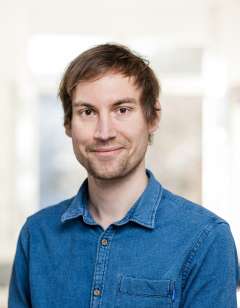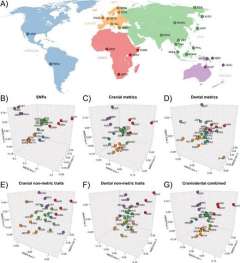Various evolutionary forces shape the human skeleton
Senckenberg Centre for Human Evolution and Palaeoenvironment at the University of Tübingen explores skeletal features as an alternative to DNA analysis
Tübingen, 10.08.2023
Genetic kinship analyses of human bones reach their limits if the DNA is poorly preserved or if destructive sampling is not possible. New research shows that in such cases, comparisons of the structure and shape of certain parts of the skeleton may also provide detailed information about relationships, and do so non-destructively. This is the result of a large-scale study by an international research team led by Dr. Hannes Rathmann and Professor Katerina Harvati from the Senckenberg Centre for Human Evolution and Palaeoenvironment and the Institute for Archaeological Sciences at the University of Tübingen.
The team analyzed large genetic and skeletal datasets to determine the extent to which human genetic diversity worldwide is reflected in the morphology – i.e, the structure and shape – of skeletal parts. The researchers obtained the best results when comparing certain dental and cranial elements, yet they also found that some worked significantly better than others and this difference is likely the result of how they evolved. This basic research may be used as a reference in future archaeological and forensic investigations to arrive at more robust inferences when DNA analysis is not possible. The study has been published in the journal PNAS Nexus.
Skeletal elements preserve differing evolutionary forces
Human skeletal morphology is highly diverse and varies among individuals and populations around the globe. This diversity is the result of a complex interplay of various evolutionary forces over a long period of time. “Evolutionary biologists divide these forces into two distinct processes. A neutral process refers to mutations producing new diversity which, however, offers no direct advantages or disadvantages to the affected individuals. This new diversity then increases or decreases randomly via what is known as genetic drift within a population,” explains Hannes Rathmann. “This is contrasted with non-neutral processes, for example, when mutations do affect the fitness of an individual. As a result, the affected individuals have a greater or lesser ability to adapt to environmental factors,” he says. To draw detailed conclusions about underlying genetic kinship, he says, only skeletal elements that evolved through neutral processes should be used.
In the study, the team focused on the teeth and skull, whose structures are considered to have evolved primarily through neutral processes. “Contrary to earlier assumptions, not all features in the teeth and skull reliably reflect the underlying genetic code; some are much more suitable than others,” Rathmann says. Small morphological features on the teeth, such as groove patterns in the crowns, the number and size of cusps, the shape of the roots, and the presence or absence of wisdom teeth, proved to be particularly suitable. “However, we obtained the best results, almost identical to a conventional genetic relationship analysis, when we included all features of the skull and teeth,” he says. “This is also expected, as more skeletal features provide a richer knowledge of underlying genetic information,” he adds.
A non-destructive alternative
Katerina Harvati, the study’s senior author, adds, “The results enhance our understanding of the origins of human skeletal diversity. They are also promising for several direct applications in archaeological and forensic investigations.” Genetic analyses are often constrained by poor DNA preservation. This is commonly the case with very old bones or those that have been exposed to a warm climate, Harvati explains. Damaging bones for DNA analyses is also often out of the question in the case of fragile material or rare finds, or due to ethical reasons. “In such cases, the non-destructive examination of skulls and teeth is a valuable alternative for tracing past population history and hominin phylogeny in archaeological contexts, for example, or for infering ancestry profiles in forensic cases. This work, therefore, has implications for the scientific community and society at large,” Harvati says.
Publication:
Hannes Rathmann, Silvia Perretti, Valentina Porcu, Tsunehiko Hanihara, G. Richard Scott, Joel D. Irish, Hugo Reyes-Centeno, Silvia Ghirotto, Katerina Harvati (2023): Inferring human neutral genetic variation from craniodental phenotypes. PNAS Nexus, Volume 2, Issue 7, pgad217, https://doi.org/10.1093/pnasnexus/pgad217


